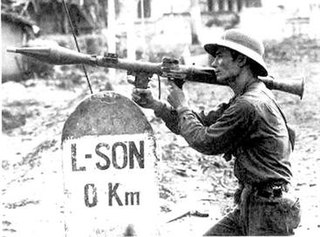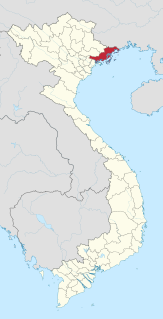 W
WThe Sino-Vietnamese War was a border war fought between the People's Republic of China and the Socialist Republic of Vietnam in early 1979. China launched an offensive in response to Vietnam's invasion and occupation of Cambodia in 1978.
 W
WThe 150th Army Division (3rd Formation) was formed in November 1967 from 1st, 5th, 10th and 12th Independent Regiments, Independent Infantry Battalion and Independent Antiaircraft Battalion of Chengdu Military Region.
 W
WThe Ba Chúc massacre was carried out by the Kampuchean Revolutionary Army from April 18 to April 30, 1978 in Ba Chúc, Tri Tôn, An Giang Province, Vietnam. Of those who had lived in Ba Chúc, 3,157 civilians were killed. Only two survived the massacre. In addition, more than 200 people were killed or injured by land mines deployed by the Khmer Rouge upon retreat.
 W
WThe Battle of Lào Cai was fought between Chinese and Vietnamese forces during the Sino-Vietnamese War. Though the Chinese sustained heavy losses in fighting, they were successful in capturing and occupying the city of Lào Cai and the surrounding towns.
 W
WThe Cambodian–Vietnamese War, known in Vietnam as the Counter-offensive on the Southwestern border, and by Cambodian nationalists as the Vietnamese invasion of Cambodia, was an armed conflict between Democratic Kampuchea, controlled by the Khmer Rouge, and the Socialist Republic of Vietnam. The war began with repeated attacks by the Kampuchean Revolutionary Army on the southwestern border of Vietnam, particularly the Ba Chuc massacre which resulted in the deaths of over 3,000 Vietnamese civilians. On 25 December 1978, Vietnam launched a full-scale invasion of Kampuchea, and subsequently occupied the country and removed the government of the Communist Party of Kampuchea from power.
 W
WThe Battle of Cao Bằng was fought between the Chinese People's Liberation Army (PLA) and the Vietnam People's Army (VPA) over the city of Cao Bằng and its vicinity, from the beginning of the Sino-Vietnamese War on 17 February, to 6 March 1979. After the capture of Cao Bằng on 25 February, Chinese forces still had to struggle for days to gain control over other areas in the province against badly outnumbered Vietnamese defenders. Contrary to the Chinese intention to battle against and defeat some major regular units of the VPA, the PLA found themselves encountering mostly small units of Vietnamese border guards and militia, which had clearly outperformed their enemy.
 W
WThe Battle of Lạng Sơn was fought during the 1979 Sino-Vietnamese War, days after the Chinese People's Liberation Army (PLA) advanced 15 to 20 kilometres deep into the northern provinces of Vietnam. The fighting occurred primarily at the city of Lạng Sơn, a few kilometres from the Sino-Vietnamese border. Although the Chinese eventually occupied Lạng Sơn and its nearby vicinities during the battle, it proved during that time that the Chinese regular units invading northern Vietnam were no match against militia and irregular Vietnamese units tenaciously harassing the Chinese advance southward to Hanoi, Vietnam's capital city, and eventually took Chinese forces days to occupy the city and dislodge its defenders.
 W
WThe Battle of Lào Cai was fought between Chinese and Vietnamese forces during the Sino-Vietnamese War. Though the Chinese sustained heavy losses in fighting, they were successful in capturing and occupying the city of Lào Cai and the surrounding towns.
 W
WThe Battle of Móng Cái was fought during the Sino-Vietnamese War between 16 February and 10 March 1979 over the city of Móng Cái and other districts of Quảng Ninh Province that bordered the People's Republic of China. The battle broke out as Chinese People's Liberation Army (PLA) units launched diversionary attacks in support of the Chinese invasion in the major fronts of Lạng Sơn, Cao Bằng and Lào Cai. However, the Chinese failed to attract any Vietnamese reinforcements into the battle.
 W
WThe People's Republic of Kampuchea, also referred to as the Vietnamese occupation of Cambodia, was founded in Cambodia by the Salvation Front, a group of Cambodian communists dissatisfied with the Khmer Rouge after the overthrow of Democratic Kampuchea, Pol Pot's government. Brought about by an invasion from Vietnam, which routed the Khmer Rouge armies, it had Vietnam and the Soviet Union as its main allies.
 W
WThe Sino-Vietnamese conflicts of 1979–1991 were a series of border and naval clashes between the People's Republic of China and the Socialist Republic of Vietnam following the Sino-Vietnamese War in 1979. These clashes lasted from the end of the Sino-Vietnamese War until the normalization of ties in 1991.
 W
WGeling Yan is a prominent Chinese-American writer, author of several novels, short stories and screenplays. Much of her work has been adapted for film. She is currently represented by the Hong Kong-based Peony Literary Agency.